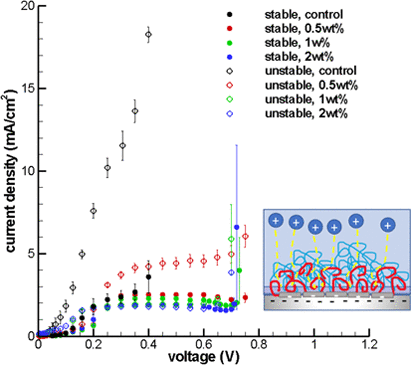当前位置:
X-MOL 学术
›
Macromolecules
›
论文详情
Our official English website, www.x-mol.net, welcomes your
feedback! (Note: you will need to create a separate account there.)
Electrodeposition of Zinc in Aqueous Electrolytes Containing High Molecular Weight Polymers
Macromolecules ( IF 5.1 ) Pub Date : 2020-03-23 , DOI: 10.1021/acs.macromol.0c00037 Duhan Zhang 1 , Alexander J. Warren 2 , Gaojin Li 2 , Zhu Cheng 2 , Xiaoxing Han 2 , Qing Zhao 2 , Xiaotun Liu 2 , Yue Deng 3 , Lynden A. Archer 2
Macromolecules ( IF 5.1 ) Pub Date : 2020-03-23 , DOI: 10.1021/acs.macromol.0c00037 Duhan Zhang 1 , Alexander J. Warren 2 , Gaojin Li 2 , Zhu Cheng 2 , Xiaoxing Han 2 , Qing Zhao 2 , Xiaotun Liu 2 , Yue Deng 3 , Lynden A. Archer 2
Affiliation

|
Strong polarization of the ion distribution in liquid electrolytes subjected to potential differences exceeding the thermal voltage, VT = kT/e, produces a hydrodynamic instability termed electroconvection at ion-selective interfaces. Electroconvection is desirable in some situations (e.g., electrodialysis) because it promotes mixing in a stagnant electrolyte layer, enhancing the ion flux at a fixed potential difference. It is undesirable in others (e.g., electrodeposition of metals) where early experiments show that convective fluid rolls associated with hydrodynamic instability in bounded electrolytes produce preferential metal deposition at localized regions on an electrode. Such localized deposition drives the family of morphological instabilities loosely termed dendritic electrodeposition. We experimentally investigate the effect of ultrahigh molecular weight polymer additives on the onset conditions and physical characteristics of both instabilities. Direct observations of electrodeposit morphology and tracer particle motions used in tandem with indirect electrokinetic measurements reveal that even at moderate concentrations, the polymer additives have a large beneficial effect in extending the range of electric potentials where stable electrodeposition is observed. Additionally, we report that at polymer concentrations above the entanglement threshold, high molecular weight polymers impart elasticity to liquid electrolytes which dampen electroconvective flow at a cation-selective interface but have at most a minimal effect on the bulk ionic conductivity of the liquid.
中文翻译:

含高分子聚合物的水电解质中锌的电沉积
液体电解质中离子分布的强极化,其电势差超过热电压,V T = kT / e在离子选择界面上产生称为电对流的流体动力学不稳定性。在某些情况下(例如,电渗析),电对流是理想的,因为它促进了停滞的电解质层中的混合,从而在固定电势差下提高了离子通量。在其他方法(例如金属的电沉积)中,这是不希望的,早期的实验表明,与约束电解质中的流体动力学不稳定性相关的对流流体辊会在电极上的局部区域产生优先的金属沉积。这种局部沉积驱动了形貌不稳定性家族,统称为树突状电沉积。我们实验研究了超高分子量聚合物添加剂对两种不稳定性的起始条件和物理特性的影响。直接观察电沉积形态和示踪颗粒运动与间接电动测量相结合,发现即使在中等浓度下,聚合物添加剂在扩大观察到稳定电沉积电位的范围方面也具有很大的有益作用。另外,我们报道了在高于缠结阈值的聚合物浓度下,高分子量聚合物赋予液体电解质以弹性,该电解质抑制阳离子选择界面处的对流,但对液体的整体离子电导率影响最小。聚合物添加剂在扩大观察到稳定电沉积的电位范围方面具有很大的有益作用。另外,我们报道了在高于缠结阈值的聚合物浓度下,高分子量聚合物赋予液体电解质以弹性,该电解质抑制阳离子选择界面处的对流,但对液体的整体离子电导率影响最小。聚合物添加剂在扩大观察到稳定电沉积的电位范围方面具有很大的有益作用。另外,我们报道了在高于缠结阈值的聚合物浓度下,高分子量聚合物赋予液体电解质以弹性,该电解质抑制阳离子选择界面处的对流,但对液体的整体离子电导率影响最小。
更新日期:2020-04-24
中文翻译:

含高分子聚合物的水电解质中锌的电沉积
液体电解质中离子分布的强极化,其电势差超过热电压,V T = kT / e在离子选择界面上产生称为电对流的流体动力学不稳定性。在某些情况下(例如,电渗析),电对流是理想的,因为它促进了停滞的电解质层中的混合,从而在固定电势差下提高了离子通量。在其他方法(例如金属的电沉积)中,这是不希望的,早期的实验表明,与约束电解质中的流体动力学不稳定性相关的对流流体辊会在电极上的局部区域产生优先的金属沉积。这种局部沉积驱动了形貌不稳定性家族,统称为树突状电沉积。我们实验研究了超高分子量聚合物添加剂对两种不稳定性的起始条件和物理特性的影响。直接观察电沉积形态和示踪颗粒运动与间接电动测量相结合,发现即使在中等浓度下,聚合物添加剂在扩大观察到稳定电沉积电位的范围方面也具有很大的有益作用。另外,我们报道了在高于缠结阈值的聚合物浓度下,高分子量聚合物赋予液体电解质以弹性,该电解质抑制阳离子选择界面处的对流,但对液体的整体离子电导率影响最小。聚合物添加剂在扩大观察到稳定电沉积的电位范围方面具有很大的有益作用。另外,我们报道了在高于缠结阈值的聚合物浓度下,高分子量聚合物赋予液体电解质以弹性,该电解质抑制阳离子选择界面处的对流,但对液体的整体离子电导率影响最小。聚合物添加剂在扩大观察到稳定电沉积的电位范围方面具有很大的有益作用。另外,我们报道了在高于缠结阈值的聚合物浓度下,高分子量聚合物赋予液体电解质以弹性,该电解质抑制阳离子选择界面处的对流,但对液体的整体离子电导率影响最小。











































 京公网安备 11010802027423号
京公网安备 11010802027423号